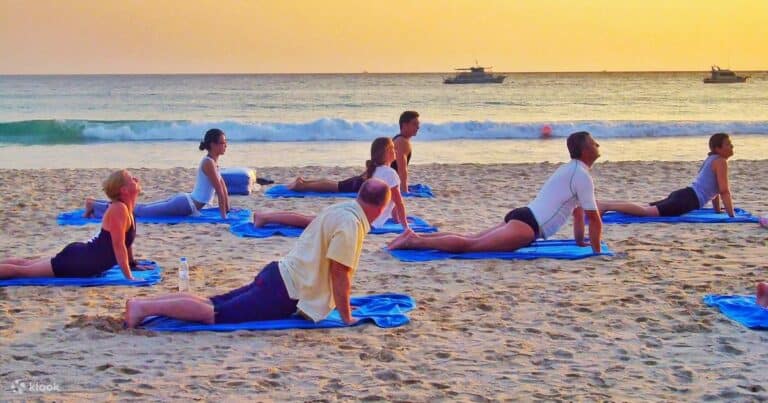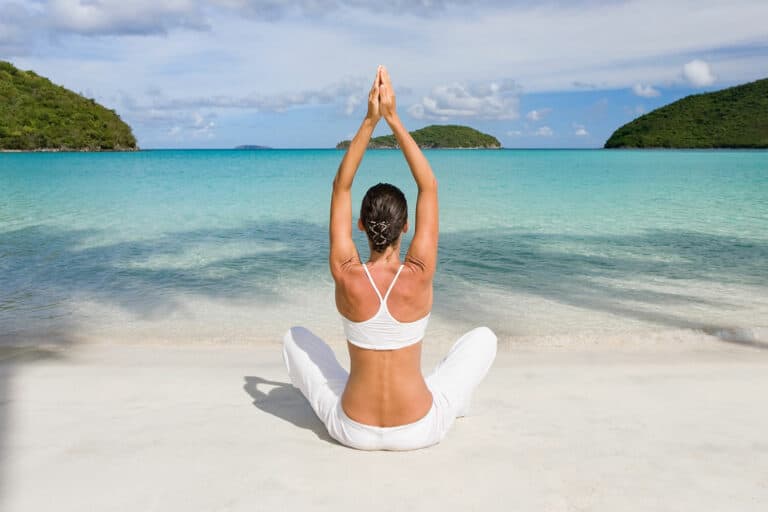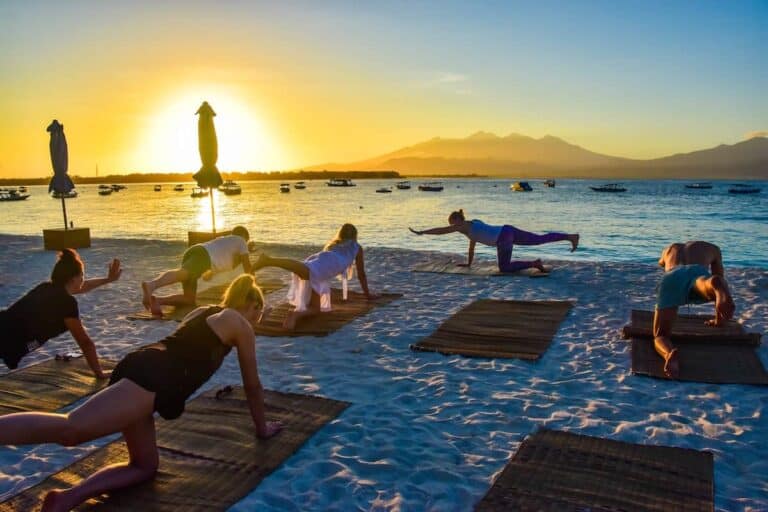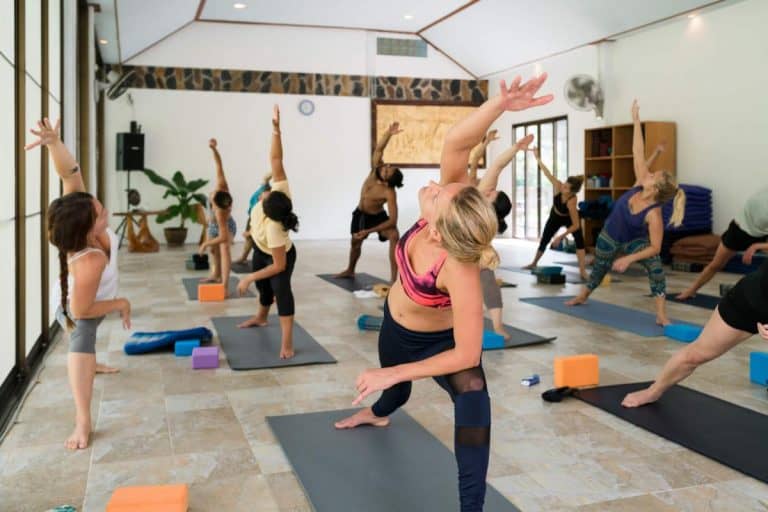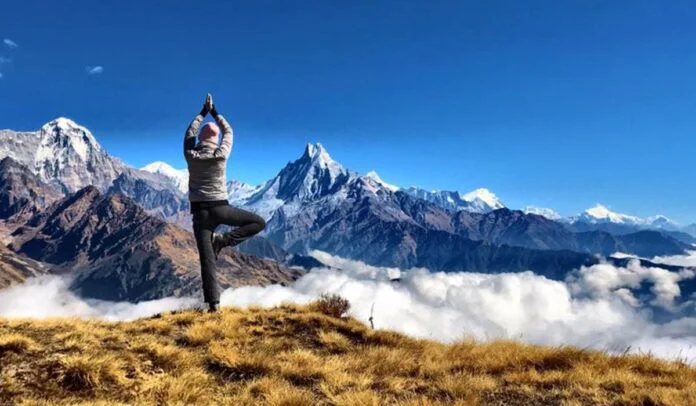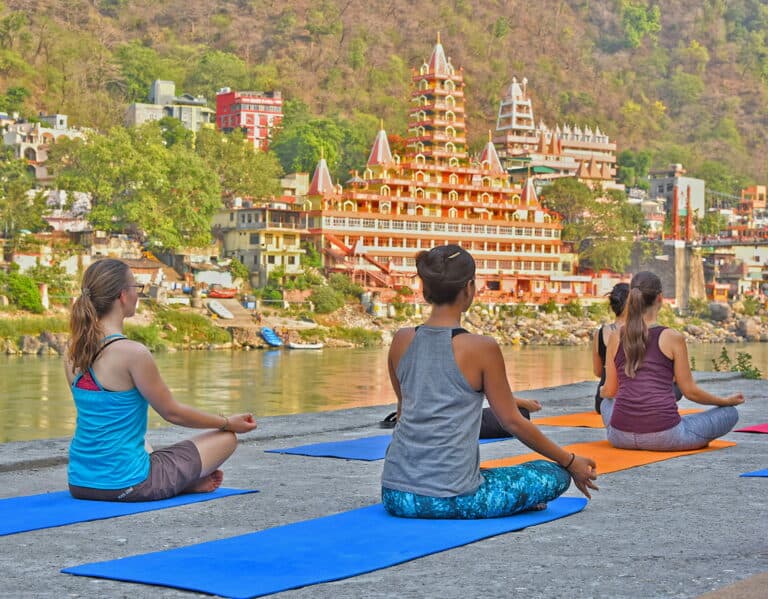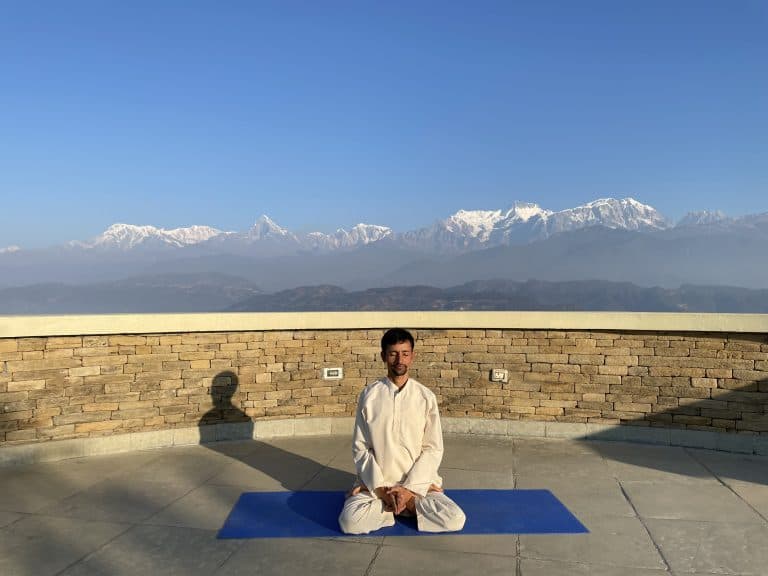Discover the numerous Mountain Pose benefits as we delve into this foundational yoga pose, exploring its impact on balance, stability, and overall well-being. Often overlooked in favor of more complex postures, the humble Tadasana is a powerful tool for developing body awareness and mindfulness.
In this blog post, we will discuss proper alignment techniques to ensure optimal support while engaging core muscles to maintain posture. We will also explore how muscle engagement in Tadasana contributes to strengthening leg muscles and activating abdominal muscles for enhanced stability.
Furthermore, learn how incorporating mindfulness techniques such as breathing exercises and visualization can improve your balance in Mountain Pose. Finally, we’ll address common mistakes made during this pose and offer corrective measures to prevent them from hindering your progress.
By effectively incorporating Tadasana into your yoga practice, you’ll reap the full spectrum of Mountain Pose benefits – both physically and mentally – making it an essential component of any well-rounded routine.
The Importance of Mountain Pose

Mountain Pose, or Tadasana, is a foundational yoga pose that helps practitioners develop proper alignment and muscle engagement while calming the mind. This basic standing posture serves as the starting point for many other poses and sequences in yoga practice. In this section, we will discuss how Mountain Pose establishes balance and stability, as well as its role in developing body awareness and mindfulness.
Establishing Balance and Stability
Incorporating Mountain Pose into your daily routine can significantly improve your sense of balance by strengthening the muscles responsible for maintaining an upright position. By practicing Tadasana regularly, you train your body to distribute weight evenly across both feet, which ultimately leads to better overall stability during various physical activities such as walking or running. Additionally, focusing on proper alignment in this pose encourages correct posture throughout everyday life – reducing the risk of injury caused by poor biomechanics.
Developing Body Awareness and Mindfulness
Mountain Pose also plays a crucial role in enhancing self-awareness through mindful movement. As you stand tall with intentionality during Tadasana practice, you become more attuned to subtle sensations within your body – allowing you to identify areas where tension may be present or where further adjustments are needed for optimal alignment. Furthermore, concentrating on steady breathing patterns while holding this pose fosters mental clarity by encouraging practitioners to remain fully present in each moment.
- Breathing exercises: Incorporate deep diaphragmatic breaths (also known as “belly breathing”) into your Mountain Pose practice; inhale slowly through the nose while expanding the abdomen before exhaling completely through either pursed lips or the nose.
- Body scanning: As you hold Tadasana, mentally scan your body from head to toe – noting any areas of tension or discomfort. Use this awareness to make necessary adjustments in alignment and muscle engagement for a more balanced posture.
Incorporating Mountain Pose into your yoga practice improves physical balance and stability and enhances mental focus through mindfulness techniques. By dedicating time each day to stand tall with intentionality, you can cultivate greater self-awareness while reaping the numerous benefits associated with proper alignment and muscle engagement.
Mountain pose is a foundational posture that helps create balance and stability in the body and cultivate awareness of one’s physical self. By understanding the proper alignment for mountain pose, practitioners can further develop their practice with confidence and strength.
Proper Alignment in Mountain Pose

Achieving correct alignment in Mountain Pose is crucial to ensure maximum benefits from this pose. It involves positioning your feet parallel, lifting your sternum, balancing your head over your hips, rooting down through the soles of your feet, and opening up the chest area. This section will discuss proper foot placement for optimal support and engaging core muscles to maintain posture.
Foot Placement for Optimal Support
In Mountain Pose or Tadasana, it’s essential to have a strong foundation by placing your feet correctly on the ground. To achieve this:
- Stand with both feet hip-distance apart and parallel to each other.
- Your heels should be slightly apart while keeping your toes pointing forward.
- Distribute weight evenly across all four corners of each foot for better balance.
- Firmly press down through the balls of both big toes and little toes as well as inner and outer edges of heels.
This balanced standing position helps you engage leg muscles effectively while providing stability during practice.
Engaging Core Muscles to Maintain Posture
To maintain an upright posture in Tadasana without slouching or overarching lower back requires activating certain muscle groups such as deep back muscles (erector spinae), abdominal muscles (rectus abdominis), shoulder blades stabilizers (rhomboids) among others:
- Deep back muscles: Gently engage the erector spinae to keep your spine long and straight. This helps in maintaining a neutral spine position, preventing excessive curvature of the lower back.
- Abdominal muscles: Draw your navel towards your spine while keeping abdominal muscles engaged throughout the pose. This provides additional support to maintain proper alignment and prevent overarching of the lower back.
- Shoulder blades stabilizers: Roll shoulders down away from ears, gently squeeze shoulder blades together and broaden across collarbones. Palms should be facing forward with arms alongside the body or extended upwards for an added challenge. This action engages rhomboids, trapezius, and other upper back muscles that help in maintaining good posture during Mountain Pose.
Maintaining this level of muscle engagement not only improves posture but also boosts energy levels by activating core strength during practice. To learn more about engaging specific muscle groups effectively in yoga poses like Tadasana or inverted poses such as Headstand (Sirsasana), explore this comprehensive guide on yoga anatomy.
Proper alignment in Mountain Pose is essential for maximizing the benefits of this pose and should be practiced with mindfulness. To further deepen your practice, focus on engaging muscle groups to improve stability and support while in Tadasana.
Muscle Engagement in Tadasana
Selective muscle engagement plays a vital role in maintaining balance during Mountain Pose. Focusing on specific areas, such as thighs, abdomen, and shoulders, can help you achieve better results while practicing this essential yoga posture. By activating these muscles consciously, you improve your overall stability and enhance the health benefits associated with this foundational pose.
Strengthening Leg Muscles
In Mountain Pose, engaging your leg muscles is crucial for establishing a strong foundation and improving balance. To activate these muscles effectively:
- Press down through all four corners of both feet to distribute weight evenly.
- Firmly engage your quadriceps (front thigh muscles) by lifting your kneecaps upwards without locking the knees.
- Activate the outer thighs by gently drawing them inward towards each other.
- Energize the inner arches of your feet by slightly lifting them off the ground to strengthen foot and ankle support.
Activating Abdominal Muscles for Stability
Your core strength plays an important role in achieving proper alignment and stability during Mountain Pose. Engaging abdominal muscles helps protect the lower back from overarching while promoting a long spine. Follow these steps to engage your core:
- Gently draw the navel toward the spine without holding your breath or tensing up excessively; think of it as “zipping” up an imaginary tight pair of jeans around the waistline area.
- Take a deep breath in and exhale, only allowing your rib cage to move.
- Hold the engagement for a few seconds, then release.
- Repeat the engagement 5-10 times, focusing on the muscles contracting and releasing.
Engaging the muscles in Tadasana helps to build strength and stability, creating a strong foundation for balance. By utilizing mindfulness techniques such as breathing exercises and visualization, one can further develop their sense of equilibrium while deepening their practice.
Enhancing Balance with Mindfulness Techniques
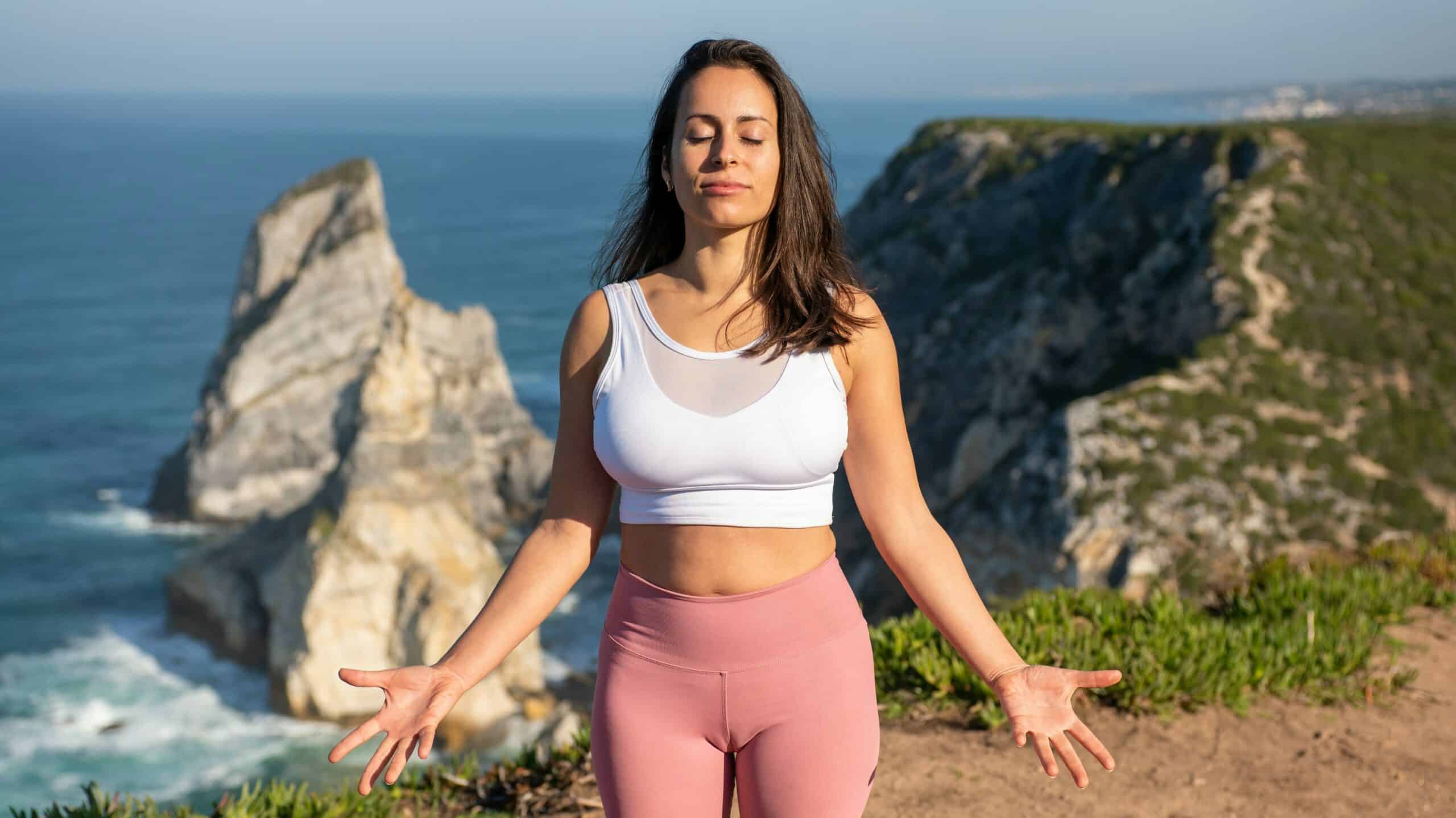
Practicing mindfulness techniques during Mountain Pose allows you to become more aware of subtle shifts within the body that affect the overall balance. By paying attention to these changes and adjusting accordingly, you can improve physical steadiness and mental focus throughout each yoga session.
Breathing Exercises to Enhance Concentration
One way to incorporate mindfulness into your Tadasana practice is by focusing on your breath. Conscious breathing exercises, such as deep belly breathing or Ujjayi breath, help calm the mind and increase concentration. To practice deep belly breathing, follow these steps:
- Inhale slowly through your nose, filling up your lungs completely.
- As you inhale, allow your abdomen to expand outward like a balloon.
- Exhale slowly through your nose or mouth while drawing the abdominal muscles towards the spine.
- Repeat this process for several breaths while maintaining proper alignment in Mountain Pose.
Visualization Techniques for Increased Self-Awareness
In addition to focused breathing exercises, visualization techniques can enhance self-awareness during Tadasana. For example, imagine yourself standing tall like a mountain – grounded at its base yet reaching high into the sky above. This imagery helps cultivate a sense of stability and strength within oneself while practicing Mountain Pose. Another effective visualization technique involves imagining an invisible string pulling gently upward from the crown of one’s head toward the ceiling. This mental image encourages lengthening the spine without straining or overextending any part of it. For more information on incorporating visualization techniques into your yoga practice, check out this guide on Yoga Journal.
By incorporating mindfulness techniques such as focused breathing and visualization into your Mountain Pose practice, you can enhance both physical balance and mental clarity. This heightened awareness will not only improve your Tadasana experience but also benefit other aspects of your overall wellbeing.
By focusing on proper breathing and visualization techniques, Mountain Pose can be used to improve balance with mindfulness. To further refine your practice of this pose, it is important to recognize common mistakes such as overarching the lower back or slouching in the upper body and learn how to correct them.
Common Mistakes & Corrections

Mountain Pose may appear simple at first glance; however, common mistakes made by beginners could lead them away from experiencing its full potential benefits if not addressed properly. This section will discuss some of these errors and provide corrective measures to help you get the most out of your Tadasana practice.
Overarching Lower Back & Corrective Measures
A common mistake in Mountain Pose is overarching the lower back, which can strain the deep back muscles such as the erector spinae. This error often occurs when practitioners try to maintain an exaggerated upright posture or push their hips forward excessively.
- Correction: To prevent overarching your lower back, engage your abdominal muscles and slightly tuck in your tailbone. This action helps keep a neutral spine position while maintaining core strength.
- Tips: Imagine lengthening through the crown of your head and keeping a straight line from head to heels. You can also place a hand on your lower abdomen to ensure it remains engaged throughout the pose.
Slouching Upper Body & Ways to Prevent It
Another frequent issue with Mountain Pose is slouching or rounding through the upper body due to poor postural habits developed over time. Slouching prevents proper engagement of shoulder blades and outer thighs while compromising overall alignment in Tadasana.
- Correction: To avoid slouching during Mountain Pose, actively lift through your sternum while drawing shoulder blades down towards each other along with palms facing forward for optimal chest opening effect.
Maintain a level head, elongating the back of your neck for balance. - Tips: Practice standing against a wall with your head, shoulders, and heels touching it. This can help you become more aware of proper alignment in Tadasana. Additionally, incorporate other yoga poses like Tree Pose or inverted poses that promote upper body strength and awareness.
By addressing these common mistakes in Mountain Pose, you will be able to experience its full range of health benefits, such as improved posture, increased body awareness, and boosted energy levels. Remember that consistency is key when practicing any yoga pose – so keep refining your technique for optimal results.
It is important to be mindful of common mistakes and corrections when practicing Mountain Pose in order to maximize the benefits. With some effort, you can acquire the skill of integrating Tadasana into your yoga practice to make it even more enjoyable.
Incorporating Tadasana into Your Yoga Practice
Mountain Pose can be seamlessly integrated into your yoga practice, serving as a starting point for various sequences or as a standalone pose to improve posture and balance. Regularly incorporating Tadasana will help you achieve better alignment in other poses too.
Using Mountain Pose as a Warm-Up
Begin your yoga session with Mountain Pose to activate the necessary muscles and set the foundation for proper alignment throughout your practice. As you stand tall in this foundational yoga pose, focus on engaging your leg muscles, abdominal muscles, and shoulder blades while maintaining steady breathing. This warm-up helps boost energy levels, increase body awareness, and prepare you mentally for more challenging poses.
- Feet hip-distance apart: Stand with feet parallel and heels slightly apart to establish stability.
- Erector spinae activation: Engage deep back muscles by lengthening the spine long without overarching the lower back.
- Pelvic neutral position: Keep hips leveled by drawing tailbone down towards heels while lifting pubic bone up towards navel.
Transitioning from Tadasana to Other Standing Postures
The principles of balance and alignment learned through practicing Mountain Pose can be applied when transitioning into other standing postures such as Tree Pose or Warrior I. By establishing a strong foundation in Tadasana first, it becomes easier to maintain proper form during these more complex poses, which require additional strength and flexibility.
- To transition into Tree Pose (Vrksasana): From Mountain Pose, shift your weight onto one foot and place the sole of the other foot on your inner thigh or calf. Keep your spine long, core engaged, and palms facing forward.
- To transition into Warrior I (Virabhadrasana I): From Tadasana, step one foot back while bending the front knee to a 90-degree angle. Maintain alignment by keeping hips squared towards the front of your mat and engaging both outer thighs.
Incorporating Mountain Pose into various sequences improves overall balance and helps develop greater stability in more advanced standing poses like inverted poses or balancing postures. Regularly engaging in Tadasana can bring noticeable enhancements in posture, core power, and bodily consciousness that will help your practice.
Frequently Asked Questions Mountain Pose Benefits
What are the benefits of mountain pose for kids?
Mountain Pose offers numerous benefits for children, including improved posture, increased body awareness, and enhanced focus. By practicing Tadasana regularly, kids can develop a strong foundation in balance and stability while also cultivating mindfulness skills that will serve them well throughout their lives.
What is your experience of doing mountain pose in yoga?
As an advanced practitioner, my experience with Mountain Pose has been transformative. This foundational asana helps me establish proper alignment and grounding at the beginning of each practice session. It serves as a powerful reminder to stay present and focused on breathwork while building strength and stability in both body and mind.
What are the benefits of one-legged mountain pose?
One-legged Mountain Pose (Eka Pada Tadasana) provides additional challenges compared to its two-legged counterpart. The unilateral nature of this variation enhances balance, coordination, core strength, and proprioception. Moreover, it aids in developing mental focus by requiring greater concentration during execution. Learn more about Eka Pada Tadasana here.
Conclusion
In conclusion, practicing Mountain Pose offers numerous benefits for both physical and mental wellbeing. It helps establish balance and stability, develops body awareness and mindfulness, strengthens leg muscles, activates abdominal muscles for stability, and enhances concentration through breathing exercises and visualization techniques.
You can reap the rewards of this foundational pose by incorporating Tadasana into your yoga practice as a warm-up or transitioning from it to other standing postures. Remember to focus on proper alignment by placing your feet for optimal support and engaging core muscles to maintain posture.


